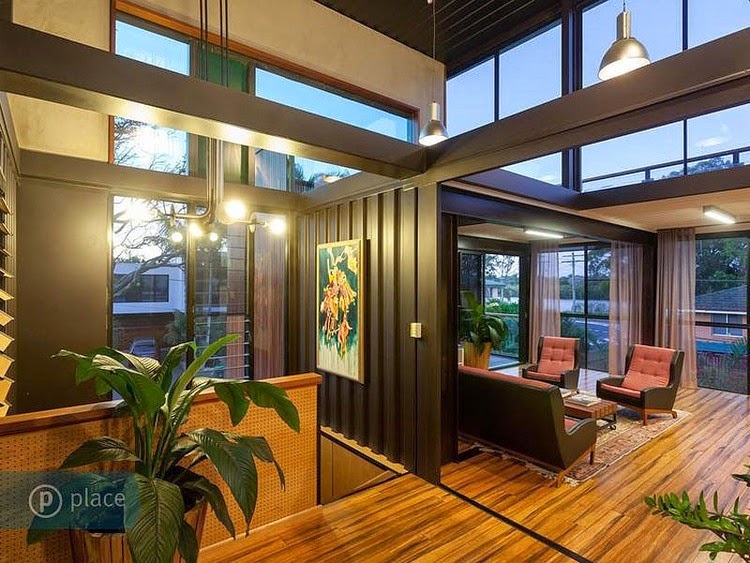Córdoba, 27 feb (EFE).- Una familia cordobesa se está construyendo
una vivienda utilizando cuatro contenedores de puertos que darán lugar a
un inmueble de 120 metros cuadrados, dos plantas y con un ahorro
económico que ronda el 15 por ciento respecto a una vivienda
tradicional.
El arquitecto de Tercera Piel Arquitectura, Francisco
Carmona, diseñador del proyecto, ha informado a Efe de que se trata de
una casa singular y única, ya que hasta ahora en España se venían
utilizando estos contenedores fundamentalmente para fabricar aulas o
salas de exposiciones.
La vivienda se está construyendo en una
nave industrial de Lucena (Córdoba) de la empresa Autoportantes Hipur
Sur y contará con un salón, una cocina, dos dormitorios, dos baños, una
zona de despachos y una terraza distribuidas entre dos contenedores de
40 pies y dos contenedores de 20 pies.
Cerca de una quincena de
constructores, fontaneros y electricistas están dando forma a un
inmueble que tendrá una mayor eficiencia energética que los habituales,
con la misma belleza estética y las mismas comodidades (grandes
ventanales, calefacción, aire acondicionado) que las casas de cemento y
ladrillo.
Además, las paredes llevan pintura de microesfera de
cerámica líquida que permite mantener una temperatura estable a la chapa
ondulada del contenedor.
Esta chapa ondulada puede ser tapada con
revestimientos para no recordar al inquilino que se encuentra en un
contenedor, aunque en el caso de esta vivienda de Córdoba sus
propietarios han preferido que se vea lo que en su día fue, ha detallado
el arquitecto.
En cuanto a las ventajas, Carmona ha resaltado el
ahorro de tiempo y dinero que proporciona el construirse un contenedor
habitable.
La casa estará terminada en unos cuatro meses frente al año y medio o dos años que tardaría una de obra.
En
el aspecto económico, estos contenedores supondrán un gasto de 73.000
euros frente a los más de 100.000 euros que valdría en el mercado una
casa de ladrillo con las mismas características.
Por ello, Carmona ha detallado que el ahorro medio ronda los 20.000 o 25.000 euros con esta pionera iniciativa.
La
casa contenedor es fácilmente moldeable ya que se puede cambiar, añadir
o quitar contenedores según las necesidades o gustos de los
propietarios, quienes además pueden llevarse la casa en caso de que
tengan que mudarse a otra ciudad.
El arquitecto ve viable que los
contenedores puedan ocupar la gran cantidad de solares urbanizados sin
construir que ha dejado la crisis mientras se reactiva el mercado
inmobiliario tradicional.
Por su parte, el gerente de
Autoportantes Hipur Sur, Felipe Molero, ha dicho que se han embarcado en
este proyecto porque intentan "buscar siempre novedades y cosas
imaginativas que aporten algo interesante".
Ha señalado que en el
futuro puede ser un buen nicho de mercado aunque "primero hay que
cambiar la mentalidad de la gente de este país", acostumbrada a la casa
de obra tradicional.
Esta modalidad arquitectónica nació en
Londres, aunque la idea del contenedor habitable llegó hasta Estados
Unidos, Japón, Argentina y Holanda, donde empezaron a incorporar este
tipo de espacios tanto para viviendas como para oficinas, locales
comerciales, escuelas o galerías de arte.
Via EFE
Fuente Original
http://newscaster.ikuna.com/60_videos-del-dia/1948266_los-contenedores-habitables-reducen-un-15-por-ciento-el-precio-de-la-vivienda-habitual.html
No es soló lo que hacemos sino como lo hacemos.
Dicho y hecho. El
alcalde de Nueva York, Michael Bloomberg, anunció en julio que la ciudad
iba a apostar por construir microapartamentos y medio año después ya
conocemos el diseño de esas microviviendas... literalmente.
En NY hay 1,8 millones de hogares conformados por una o dos personasEl
propio Bloomberg acaba de desvelar el diseño de los primeros
microapartamentos –de entre 23,2 y 34,4 metros cuadrados– con los que
busca adaptarse a las necesidades demográficas de sus habitantes y
ofrecer opciones de alquiler más asequibles.
"La capacidad de Nueva York para adaptarse a los nuevos tiempos nos hizo
la mejor ciudad del mundo y va a ser lo que nos mantenga fuertes en el
siglo XXI", dijo Bloomberg al hacer el anuncio desde el Museo de la
Ciudad de Nueva York, donde se ha inaugurado una muestra sobre los
nuevos tipos de vivienda en la Gran Manzana.
El Departamento de Preservación y Desarrollo de Vivienda de la ciudad
lanzó en julio pasado un concurso de diseño con el fin de recibir
diferentes propuestas para la construcción de un edificio compuesto por
microapartamentos en Manhattan, una de las islas con mayor densidad de
población del planeta.
Los precios de los alquileres rondan en Manhattan máximos históricosEl
proyecto ganador ha sido My Micro NY, que propone construir el primer
edificio modular de Nueva York, compuesto por 55 módulos prefabricados
de entre 23,2 y 34,4 metros cuadrados cada uno, que contarán con unos
techos de cerca de 3 metros de altura y balcones al exterior.
La promotora Monadnock ha creado esta propuesta junto a Actors Fund
Housing Development y la firma de arquitectos nARCHITECTS. El edificio
contará con múltiples áreas comunes, como una azotea con jardín, un
café, una sala de actividades en la planta baja, un gimnasio, un área de
lavado, trasteros y espacio para aparcar bicicletas.
El 40% de estos microapartamentos se ofertarán a precios inferiores a
los del mercado y estarán reservados para neoyorquinos con rentas bajas y
medias, con lo que se busca ofrecer opciones más económicas de alquiler
en Manhattan, donde los precios de los alquileres rondan máximos
históricos.
Un precedente para cambiar la ley
Cuando el Ayuntamiento de Nueva York decidió iniciar este concurso,
aseguró que actualmente hay 1,8 millones de hogares formados únicamente
por una o dos personas en esta urbe, pero sólo existen un millón de
estudios y apartamentos que consten de un dormitorio.
Su tamaño está por debajo del permitido por la ley: al menos 37 m2Las
reducidas dimensiones de los microapartamentos están por debajo de las
permitidas por la ley de zonificación vigente, que establece que los
apartamentos de la ciudad deben medir al menos 37 metros cuadrados, pero
se eximirá de estas regulaciones al terreno municipal donde se erigirá
el nuevo edificio.
"La tasa de crecimiento de hogares de una o dos personas excede por
mucho la de las familias de tres o más, por lo que abordar ese desafío
urbanístico requiere pensar de forma creativa y fuera de nuestras
actuales regulaciones", añadió Bloomberg.
De hecho, si este programa piloto resulta exitoso, la ciudad podría
acabar con esa normativa de 1987 para poder construir más edificios de
microapartamentos.
Ver más en:
http://www.20minutos.es/noticia/1709370/0/nueva-york/diseno-primeras/microviviendas/#xtor=AD-15%26xts=467263#xtor=AD-15&xts=467263














































